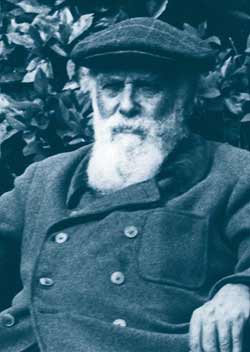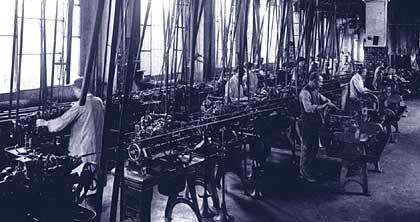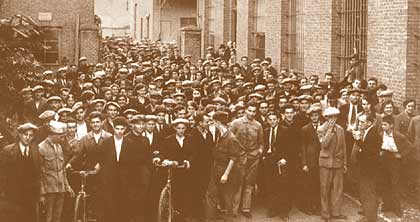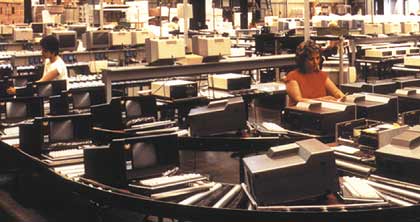Ivrea and Olivetti

The small city of Ivrea is situated in Piedmont in Italy, in the Canavese district. This area is particularly interesting from a geographical and geological point of view: it is very well known for its lakes, for the presence of a natural park, Parco del Gran Paradiso - the first Italian national park, created in 1922 - and, above all, for a morainic hill, La Serra, 25 kilometres long, created by glacial action, its skyline - a long straight line - marking the horizon and the landscape.
The name of Olivetti is linked closely with Ivrea and the Canavese district. The history of the company and the economic, social, and cultural history of the district have been bound together for over a century. Ivrea is the most well-known place in Italy where the ideas of the Modern Movement in architecture found a fertile field of experimentation. The architecture of the city, linked to Olivetti, was made by well-known Italian architects and planners, who had the possibility to create new models and languages in architecture, re-thinking all the international experiences in a very Italian and original way.
The 1990s in Ivrea were marked by the productive and financial crisis of Olivetti that by 2003 caused the complete decay of the industrial units and the definitive transfer of the company trade-mark. An economic and cultural strategy based on a number of schemes was drawn up during 1997-1998. The programme was titled Officine Culturali ICO, in which the term "Officine" (workshops) supported by the adjective "Culturali" (cultural) explicitly evoked the city's link with the industrial past and with the Olivetti company's conception of the role of industry in society.
A part of this complex project was the Open-air Museum of Modern Architecture in Ivrea, which was launched in 1999 and opened in 2001. After the founding of the Museum, several large public programmes for the appreciation of the city's rich heritage of modern architecture took place, becoming a resource to support the economy of the former industrial city.
» PDF (10,1Mb)
|
Camillo Olivetti
Camillo Olivetti (1868-1943)

Camillo Olivetti was born in Ivrea in1868. He graduated at the Regio Museo Industriale in Turin (the future Turin Polytechnic) in 1891 under the direction of the physician Galileo Ferraris. In 1896 with two partners, Dino Gatta and Michele Ferrero, he set up the first industrial plant in Ivrea, the GCS (Grammo/Gramme, Centimetro/Centimetre, Secondo/Second), which produced electrical measuring instruments. At the same time, he began construction of a first building, the so-called "red brick factory". In 1904 the factory relocated to Milan. In 1908 the Societŕ ing. C. Olivetti & C. (ICO) was founded and production activity returned in Ivrea.
» PDF (13,3Mb)
|
The first Olivetti

After returning to Ivrea following a second trip to the USA in 1903 to purchase more modern machinery and to acquire technology, Camillo Olivetti began research on the first typewriter. In 1911, the M1 typewriter was presented at the International Exposition in Turin. Also at this time, Olivetti began to design and produce machine tools alongside typewriters.
During the First World War, war production substituted the usual production of typewriters: munitions, gun and machine-gun parts, gyroscopes for torpedoes and magnets for aeroplane engines came out of the Olivetti workshops. In 1914 the number of employees increased to about 200 factory workers and 70 office workers. In 1924 production reached about 4000 machines per year with 400 factory workers. In 1926, there were 500 employees and the annual production reached 8000 machines. Production increased to 13,000 machines by 1926. In 1932 Olivetti became a joint-stock company with capital worth 13.000.000 lire.
» PDF (10,9Mb)
|
Adriano Olivetti

In 1933 Adriano Olivetti, son of Camillo, became General Manager of the Olivetti company. He was born in Ivrea in 1901. He graduated in 1924 in industrial and chemical engineering at the Turin Polytechnic. The following year he travelled to the USA. The crucial experiences for him were a visit to the Ford works in Highland Park and River Rouge and the Lincoln works in Detroit. On his return to Ivrea, Olivetti began to work in the factory. Over the following years a series of profound transformations took place in the company and its activities. Olivetti's energy was also directed to the products and their image: in 1928 an advertising department was established, directed by Olivetti himself.
Collaboration with artists and architects began to be established also from the viewpoint of industrial architecture. In 1934 Luigi Figini and Gino Pollini were asked by Adriano Olivetti to build the first expansion of the factory, built in red brick. This commission indicates a desire on the part of Olivetti to work with those Italian architects nearest to international modern architecture.
In February 1943 Adriano Olivetti sought refuge in Switzerland where he encountered numerous exiled Italian liberal intellectuals. In May 1945 he returned to Ivrea and a new phase of reorganization and expansion in the company began. In 1958, the number of Olivetti employees in Italy reached 14,200 with a further 10,000 employed by its 17 associated companies elsewhere in the world.
Productive expansion was also accompanied by the physical expansion of the factory. In the 20 years following WWI due to saturation of area, the factory complex moved to via Jervis and the territory surrounding Ivrea.
» PDF (6,1Mb)
|
Industrial expansion

In an expansion phase that lasted from the late fifties to the early sixties, Olivetti managed to acquire 27% of the world market in typewriters and 33% in calculators. The late fifties also marked the company entering the electronic sector. However, in this same period the company suffered a setback. The acquisition in 1958 of a majority share in the Underwood company, a world leader in the typewriter sector, left Olivetti excessively exposed financially.
The death of Adriano Olivetti in 1960 was a cruel blow to the company at a time when it was trying to overcome its debts. The critical financial situation inherited by the new management led to a radical corporate reorganisation. The economic measures were based on a policy of cutbacks and sell-offs: the most important measure was the sale to General Electric of the company's large electronic processing section. The early eighties was a period of intense activity in the telecommunication and telematics field, and this trend was further sanctioned by the agreement signed with the American company AT&T that bought a minority share in Olivetti. At the outset of the last decades, however, the prospects for industry at Ivrea and in the Canavese district appeared to have changed. Much activity has been transferred to areas with lower labour costs, while the more promising sectors now appear to be services and research.
In 2002 Olivetti was finally absorbed by Telecom (Italian telephone holding), this change marking the final decline of the company.
» PDF (1,9Mb)
|
|

|
|
